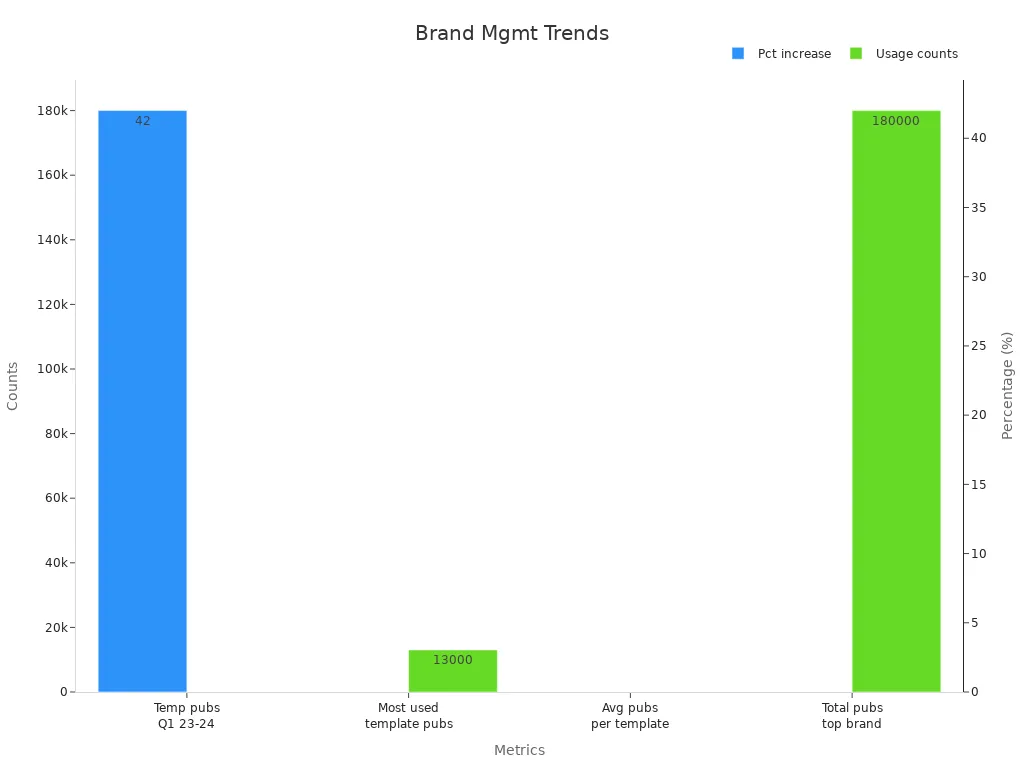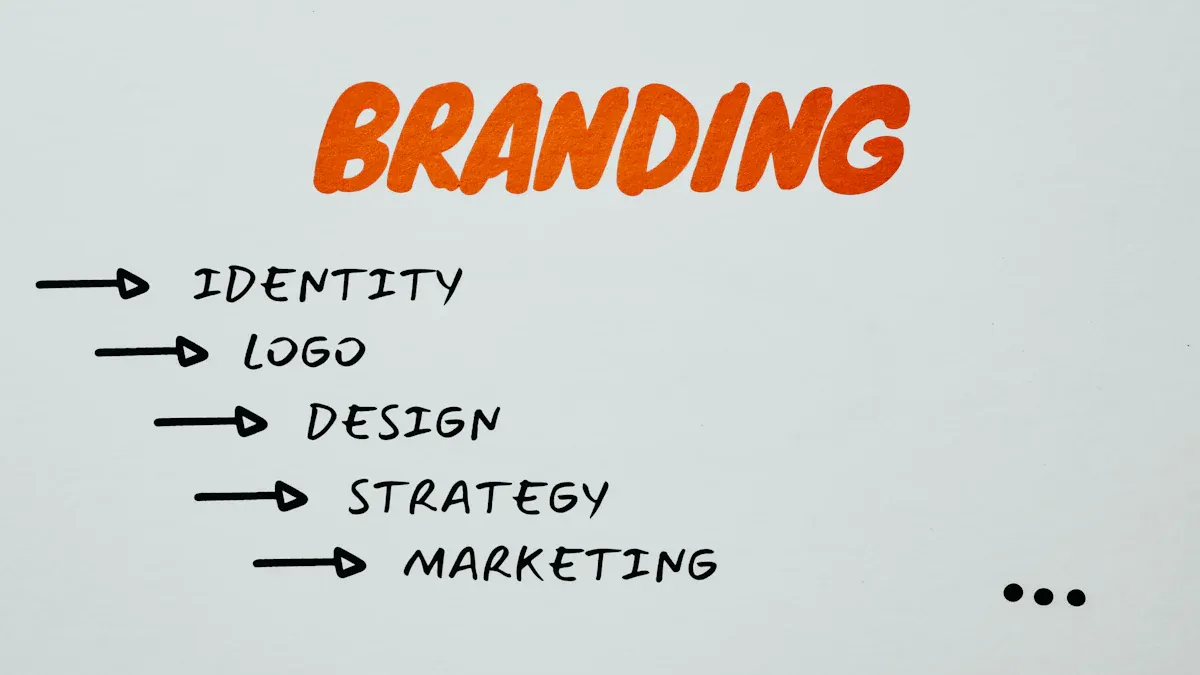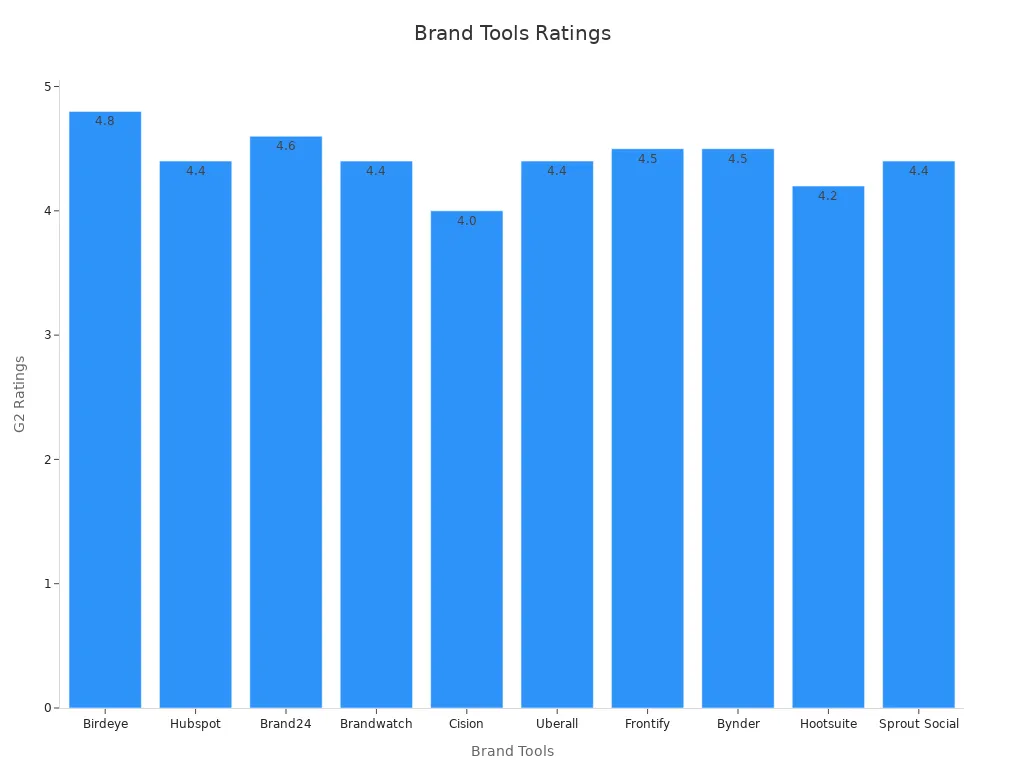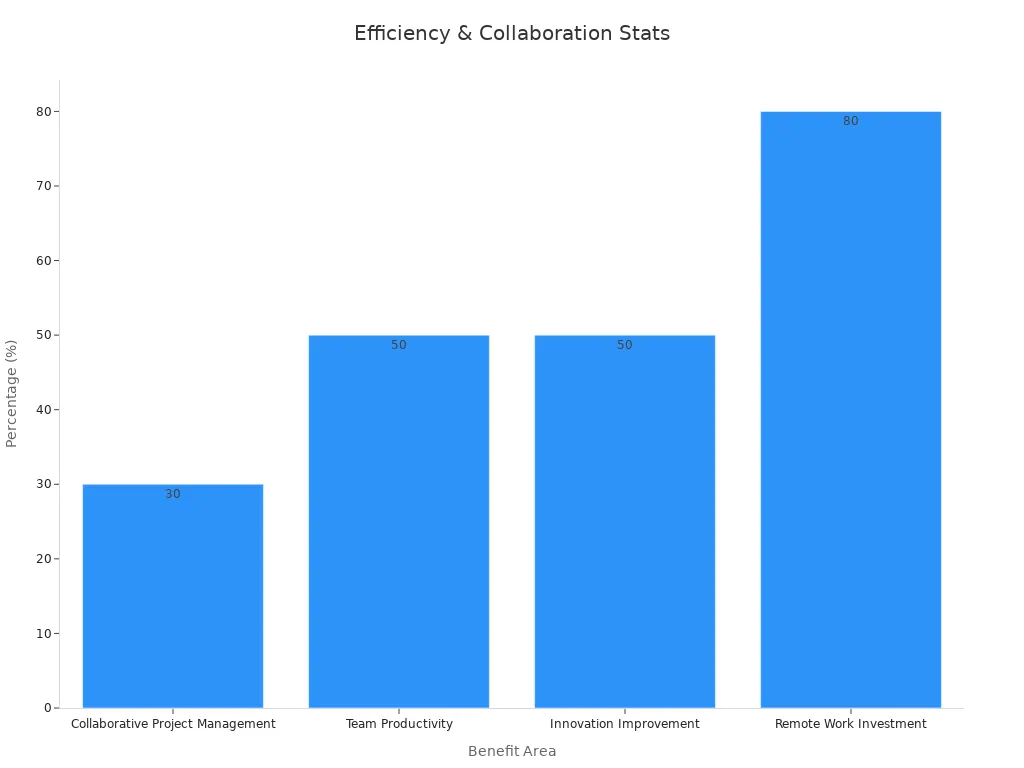Best Brand Management Tools Compared for Features, Pricing, and User Ratings

You want the best brand management tools for 2025, and Brands.menu leads the pack with its innovative Brand Management Suite. Selecting the right tools helps you ensure brand consistency and streamline your workflow. BrandLife found that marketers lose 8.8 hours weekly searching for files, making centralized solutions essential for efficiency. Top-rated tools stand out for their features, pricing, and user ratings, empowering you to manage every brand asset with confidence.

Key Takeaways
Choose brand management tools that centralize your digital assets and support collaboration to keep your brand consistent and save time.
Look for features like asset management, real-time analytics, automation, and strong security to boost efficiency and protect your brand.
Top tools vary in focus—some excel at social listening, others at asset management or market research—so pick one that fits your brand’s needs.
Using brand management software improves teamwork, speeds up projects, and helps you make smart, data-driven decisions.
Try free trials to test usability and find a tool that scales with your business while fitting your budget and goals.
What to Look For
Essential Features
When you evaluate brand management tools, you want features that support every aspect of your brand strategy. Look for tools that centralize digital brand assets, making it easy to access approved materials at any time. Modern platforms offer built-in analytics and reporting, so you can track brand tracking metrics and measure engagement. You should expect:
Digital Asset Management (DAM) for storing and organizing brand assets
Real-time brand tracking and sentiment analysis
AI-driven automation for asset creation and customer service
Custom workflows and approval processes
Integration with other software systems
Collaboration features for teams
Strong data security measures
Scalability to adapt as your brand grows
These features help you maintain brand recognition and streamline your brand awareness efforts.
Key Benefits
Brand management tools deliver measurable benefits that drive your brand forward. The right features support brand consistency and boost efficiency across your organization. The table below shows how these benefits contribute to your overall strategy:
Key Benefit | Contribution to Brand Consistency and Operational Efficiency |
|---|---|
Increases customer retention and supports revenue growth. | |
Fostering Customer Relationships | Consistent messaging builds trust and loyalty. |
Maintaining Unified Brand Image | Ensures your brand is recognizable across all channels. |
Brand Guidelines | Provide clear expectations for messaging and visuals. |
Centralized Brand Asset Management | Improves efficiency and reduces errors in content creation. |
Internal Brand Support | Encourages employees to embody brand values. |
Brand Asset Management Software | Enables controlled access to assets, supporting consistent branding through changes. |
Selection Criteria
You want to choose tools that align with your brand strategy and support your goals. Consider these criteria:
Integration with your existing systems
Scalability for future growth
User experience that encourages engagement
Security to protect your brand assets
Automation to improve efficiency
Collaboration tools for team alignment
Analytics for ongoing brand tracking
Selecting the right brand management tools ensures your brand stands out, maintains consistency, and achieves lasting engagement.
Top Brand Management Tools

Comparison Table
When you compare brand management tools, you want clear information to help you decide. The table below highlights the most popular options for 2025. You can see the main features, best use cases, pricing, and user ratings for each software. This overview helps you find the right tools for your brand’s needs.
Tool | Key Features | Best Use Cases | Pricing (Starting) | User Ratings (out of 5) |
|---|---|---|---|---|
Brands.menu | Centralized dashboard, campaign analysis, creative-friendly interface, cross-platform ad browsing, brand comparison | Online brands, agencies, creative teams | $49/mo (Pro) | 4.8 |
Attest | Market research, brand tracking, audience insights | Market research, brand health | $1000/mo | 4.6 |
Birdeye | Review management, listings, customer feedback | Reputation, local businesses | $299/mo | 4.7 |
Brand24 | Social listening, analytics, sentiment analysis | Social media, PR, monitoring | $79/mo | 4.5 |
Brandwatch | Social intelligence, analytics, reporting | Enterprise, analytics teams | $1080/mo | 4.7 |
Bynder | Digital asset management, brand guidelines | Large brands, asset libraries | $450/mo | 4.5 |
Cision | PR management, media monitoring, analytics | PR, communications | Custom | 4.4 |
Frontify | Brand guidelines, asset management, collaboration | Brand teams, design teams | $99/mo | 4.6 |
Hootsuite | Social media management, scheduling, analytics | Social media, agencies | $99/mo | 4.4 |
HubSpot CRM | CRM, marketing automation, reporting | Sales, marketing, agencies | Free/$50/mo | 4.5 |
Sprout Social | Social media management, analytics, engagement | Social media, customer care | $249/mo | 4.6 |
Tip: You should always check the latest pricing and ratings before you choose any brand management tools. Software providers update their plans and features often.
You can use this table to compare the features that matter most to your brand. Some tools focus on digital asset management, while others excel in social listening or analytics. User ratings give you insight into real-world satisfaction. Pricing varies, so you can find software that fits your budget and needs. With this information, you can shortlist the best brand management tools for your business.
In-Depth Reviews
Brands.menu
Brands.menu stands out among brand management tools with its Brand Management Suite, designed for online brands and marketers who want a centralized solution. You get a dashboard that brings all your brand tracking, campaign analysis, and creative assets together. The platform gives you a clear visual timeline of your brand messaging, letting you review ad performance over 30, 90, or 365 days. This helps you track what works and optimize your strategy.
You will appreciate the creative-friendly interface, which avoids overwhelming analytics and focuses on actionable insights. Brands.menu supports cross-platform ad browsing and lets you compare your brand with others, giving you a competitive edge. The upcoming competitor analysis feature will further enhance your ability to benchmark your brand.
Brands.menu offers flexible subscription plans. The Pro plan suits businesses with 100 credits per month and advanced insights, while the Enterprise plan targets agencies with 500 credits, premium features, and priority support. You can start with a free trial that includes 10 credits. This approach ensures you only pay for what you need, making it easy to scale as your brand grows.
Brands.menu is ideal for creative teams, agencies, and marketers who want a streamlined, user-friendly brand management software that centralizes all brand activities and insights.
Attest
Attest provides a robust market research platform that helps you understand your audience and track brand health. You can use its brand tracking features to monitor awareness, perception, and sentiment over time. Attest excels at delivering actionable insights through customizable surveys and real-time analytics.
This tool is best for brands that prioritize data-driven decision-making and need to validate marketing strategies quickly. Pricing starts at $1,000 per month, reflecting its focus on enterprise-level research capabilities. While user ratings are not widely published, Attest is recognized for its depth in market research and brand tracking.
Birdeye
Birdeye specializes in online reputation management. You can aggregate reviews from multiple platforms, use sentiment analysis to gauge customer feelings, and manage your brand’s online presence efficiently. The software makes it easy to respond to feedback and improve your brand’s reputation.
Birdeye is perfect for businesses that rely on customer reviews, such as local businesses and service providers. Pricing depends on the number of locations, and the platform receives high user ratings, averaging 4.8 stars. You benefit from its comprehensive review management and strong analytics.
Brand24
Brand24 focuses on social media monitoring and analytics. You can track brand mentions, analyze sentiment, and receive customizable alerts for crisis management. The platform supports keyword-based monitoring and influence scoring, making it suitable for small businesses and agencies.
Pricing starts at $99 per month, with full features available at $249 per month. Brand24 earns a user rating of 4.6 stars. You gain real-time insights into your brand’s online presence and can respond quickly to emerging trends.
Brandwatch
Brandwatch delivers advanced social media listening and analytics. You can analyze conversations, measure campaign ROI, and manage your brand’s reputation across digital channels. The software supports deep brand tracking and reporting.
Brandwatch is best for enterprise teams that need comprehensive analytics and campaign management. Pricing is available upon request, and user ratings average 4.4 stars. You benefit from its powerful data analysis and reporting features.
Bynder
Bynder offers digital asset management and automated workflows. You can organize brand assets, maintain consistency, and streamline content creation. The platform supports collaboration and brand guidelines, making it easy to manage large libraries of creative materials.
Bynder is ideal for large brands and organizations with complex asset needs. Pricing is available on request, and user ratings stand at 4.5 stars. You gain efficiency and control over your brand’s visual identity.
Cision
Cision focuses on media monitoring, influencer management, and media outreach. You can track earned media, identify key influencers, and manage relationships with journalists. The software helps you measure the impact of PR campaigns and brand mentions.
Cision suits PR professionals and communications teams. Pricing is custom, and user ratings average 4 stars. You benefit from its comprehensive media analysis and outreach tools.
Frontify
Frontify provides digital asset management, brand guidelines, and collaboration features. You can build immersive brand experiences and ensure consistency across all channels. The platform supports team communication and creative workflows.
Frontify works well for brand and design teams. A free trial is available, with pricing based on active users. User ratings average 4.5 stars. You gain a centralized hub for all brand assets and guidelines.
Hootsuite
Hootsuite enables you to schedule posts, monitor social media, and analyze engagement across platforms. The software supports team collaboration and provides analytics to track brand performance.
Hootsuite is a top choice for social media managers and agencies. Plans start at $99 per month, and user ratings average 4.2 stars. You can manage multiple accounts and measure the impact of your social campaigns.
HubSpot CRM
HubSpot CRM offers an all-in-one marketing platform with CRM, email marketing, content management, and social media tools. You can use its automation and analytics features to optimize your brand’s online presence.
HubSpot CRM is suitable for businesses seeking a unified marketing solution. Plans start at around $20 per month, with customizable bundles. User ratings average 4.4 stars. You benefit from seamless integration and robust analytics.
Sprout Social
Sprout Social delivers advanced analytics, social listening, and a content calendar. You can track brand mentions, analyze customer feedback, and plan engagement strategies. The platform supports team collaboration and reporting.
Sprout Social is best for brands focused on social media analytics and engagement. Pricing starts at $399 per month, with additional users at $299 each. User ratings average 4.4 stars. You gain deep insights into your brand’s social performance.

Uberall
Uberall targets local businesses with reputation management and location-based marketing. You can align your brand across multiple locations and manage customer feedback efficiently.
Uberall offers pricing packages named Get Found, Be Chosen, and Thrive, with quotes available upon request. User ratings average 4.4 stars. You benefit from multi-location brand alignment and strong local marketing tools.
Adobe Workfront
Adobe Workfront provides project management and workflow automation for creative and marketing teams. You can manage campaigns, assign tasks, and track progress in real time.
Workfront is ideal for large organizations that need to coordinate complex projects. Pricing is available on request. User feedback highlights its robust workflow features and integration with Adobe Creative Cloud.
Asana
Asana helps you organize projects, assign tasks, and track deadlines. You can use it to manage marketing campaigns and collaborate with your team.
Asana suits teams of all sizes. Pricing starts with a free tier, with premium plans available. User ratings consistently rank high for ease of use and flexibility.
Canva
Canva offers a user-friendly design platform for creating branded visuals. You can access templates, collaborate with your team, and maintain brand consistency.
Canva is perfect for marketing and creative teams. Pricing includes a free plan, with Pro and Enterprise options. User ratings highlight its simplicity and wide range of features.
Lucidchart
Lucidchart provides diagramming and visualization tools. You can map out brand strategies, workflows, and organizational charts.
Lucidchart works well for teams needing visual collaboration. Pricing starts with a free plan, with premium features available. User feedback praises its intuitive interface and integration options.
Mailchimp
Mailchimp delivers email marketing, automation, and analytics. You can create branded campaigns, segment audiences, and track performance.
Mailchimp is suitable for businesses of all sizes. Pricing starts with a free plan, with advanced features in paid tiers. User ratings reflect its ease of use and comprehensive marketing tools.
Wrike
Wrike offers project management and collaboration software. You can plan campaigns, assign tasks, and monitor progress with real-time dashboards.
Wrike fits marketing and creative teams. Pricing starts with a free plan, with Business and Enterprise options. User feedback highlights its flexibility and reporting features.
monday.com
monday.com provides a visual work operating system for managing projects and workflows. You can customize boards, automate tasks, and track brand initiatives.
monday.com is ideal for teams seeking flexibility and automation. Pricing starts at $8 per user per month. User ratings praise its intuitive design and scalability.
ClickUp
ClickUp combines project management, document collaboration, and automation. You can centralize brand projects and streamline workflows.
ClickUp suits teams needing an all-in-one productivity platform. Pricing starts with a free plan, with Unlimited and Business tiers. User feedback highlights its customization and feature set.
Digimind
Digimind specializes in social listening and competitive intelligence. You can monitor brand mentions, analyze trends, and benchmark against competitors.
Digimind is best for brands focused on market intelligence. Pricing is available on request. User ratings reflect its depth in analytics and reporting.
Figma
Figma offers collaborative design tools for creating and sharing brand assets. You can work with your team in real time and maintain design consistency.
Figma is popular with creative and design teams. Pricing includes a free plan, with Professional and Organization tiers. User feedback highlights its collaboration features and ease of use.
Storyteq
Storyteq provides creative automation for marketing teams. You can scale branded content production and manage digital assets efficiently.
Storyteq is ideal for brands needing rapid content creation. Pricing is available on request. User ratings note its automation capabilities and support for creative workflows.
Talkwalker
Talkwalker delivers social listening, analytics, and brand tracking. You can monitor conversations, measure sentiment, and analyze campaign impact.
Talkwalker suits brands that need comprehensive social analytics. Pricing is available on request. User ratings highlight its powerful data analysis and reporting.
Templafy
Templafy offers document automation and brand compliance tools. You can ensure all documents meet brand standards and streamline content creation.
Templafy is best for enterprises with strict brand guidelines. Pricing is available on request. User feedback praises its compliance features and integration options.
Wistia
Wistia provides video marketing software for creating, hosting, and analyzing branded videos. You can track viewer engagement and optimize video content.
Wistia is suitable for marketing teams focused on video. Pricing includes a free plan, with advanced features in paid tiers. User ratings highlight its analytics and ease of use.
Many of these brand management tools offer flexible subscription plans, including Pro and Enterprise tiers. This structure helps you select the right features and support for your brand’s needs, whether you run a startup or manage a global enterprise.
Benefits of Brand Management Software

Brand Consistency
You want your brand to look and sound the same everywhere. Brand management software gives you centralized control, so you can keep your messaging and visuals consistent across all channels and regions. This consistency builds trust with your audience and supports customer loyalty. The market for these solutions is growing fast, with the global market size expected to double from USD 261.05 million in 2023 to over USD 529 million by 2031. With real-time insights and automated asset management, you can ensure your brand always meets regulatory requirements and stands out in a crowded market.
Efficiency and Collaboration
Brand management software helps you streamline workflows and boost team productivity. You can manage projects, share assets, and communicate in one place. Teams that use collaboration tools finish projects up to 30% faster and are 50% more productive. Companies investing in these tools see a 44% rise in usage since 2019, and 80% plan to keep investing for remote work. Good communication also reduces employee turnover, saving you time and money.
Benefit Area | Statistic | Source/Study |
|---|---|---|
Collaborative Project Management | Can reduce project timelines by up to 30% | Wellingtone |
Team Productivity | Teams working well together are 50% more productive | Stanford University |
Remote Worker Productivity | Collaboration tools can increase remote worker productivity by 20-25% | Slack |

Data-Driven Insights
You gain a clear view of your brand’s performance with data-driven insights. Brand management software tracks key performance indicators such as likes, comments, shares, reach, and follower growth. You can also monitor earned media coverage, share of voice, and branded search volume. These metrics help you measure brand awareness, brand recognition, and brand reputation management. With dashboards and analytics, you can spot trends, optimize your strategy, and make informed decisions.
Track engagement: likes, comments, shares, reach, and follower growth
Monitor earned media and share of voice
Analyze branded search volume and customer sentiment
Use dashboards for real-time reporting
ROI and Growth
You want to see real results from your branding efforts. Strong brands reduce recruitment and turnover costs, improve employee engagement, and drive higher productivity. Brand management software helps you measure both direct ROI, like sales growth and cost savings, and indirect ROI, such as improved customer perception and loyalty. Companies often see a 20% increase in website traffic and a 15% boost in sales after rebranding. You can validate these benefits by tracking campaign costs, time-to-market, and customer retention. Over time, you build long-term brand equity and support business growth.
Who Should Use Brand Management Tools
Marketing Teams
You drive your brand’s growth and visibility. Brand management tools help you align every campaign with your brand strategy. You can centralize assets, monitor campaign performance, and ensure messaging stays consistent. These tools support you in tracking engagement and optimizing your strategy for better results. With access to analytics, you make data-driven decisions that boost brand recognition and market impact.
Creative Teams
You focus on delivering high-quality creative output. Brand management tools streamline your workflow and improve collaboration. You can use templates to maintain consistency and speed up content creation. Consider these key performance indicators that measure your team’s productivity and output quality:
KPI | Definition | Impact on Productivity and Output Quality |
|---|---|---|
Time from idea to campaign launch | Faster launches improve agility and brand presence. | |
Asset Utilization | Frequency of asset use across campaigns | Higher utilization reduces redundant work and ensures brand consistency. |
Team Productivity | Efficiency and output of the creative team | Better resource use and higher satisfaction boost team performance. |
You can track these metrics to optimize your creative process and deliver outstanding results.
Social Media and Customer Service
You manage customer interactions and protect your brand’s reputation. Brand management tools let you consolidate channels, respond quickly, and resolve issues efficiently. For example, Papa Johns manages over 600 cases weekly using a single platform, saving 830 hours annually. You can improve customer satisfaction by reducing first reply times and increasing resolution rates.
Metric | Benchmark / Impact |
|---|---|
Average First Reply Time | 60 minutes; faster replies increase satisfaction |
Customer Satisfaction Score | 8-10 rating; higher scores reflect better service |
Resolution Rate | Higher rates show effective support |
These tools help you deliver a seamless customer experience and strengthen engagement.
Sales and Agencies
You need actionable insights to refine your brand strategy and drive sales. Brand management tools supported by quantitative research help you target the right audience and improve messaging. Case studies show that integrating these tools can increase win rates and boost sales. For example, Hilton improved its win rate from 22% to 43% by combining research and testing. You can use these insights to enhance engagement and achieve measurable growth.
Startups and Enterprises
You face unique challenges, whether you are scaling fast or managing complex operations. Brand management tools adapt to your needs, offering scalability and security. Startups benefit from streamlined workflows and quick asset access, while enterprises gain advanced analytics and integration capabilities. You can maintain brand consistency and support your long-term strategy, no matter your size.
Choosing the Right Tool
Aligning Needs
You should start by matching your business requirements with the capabilities of brand management tools. Consider what your brand needs most—asset management, media monitoring, workflow automation, or analytics. Review the features each platform offers and compare them to your brand strategy. Here is some guidance to help you align your needs:
Look for essential features like brand asset management, workflow approvals, sentiment analysis, and reporting.
Evaluate how each tool integrates with your marketing ecosystem to maintain consistency and protect your reputation.
Compare unique capabilities across platforms. For example, Bynder excels at asset management, while Brand24 focuses on reputation monitoring.
This approach ensures you select software that supports your goals and enhances engagement.
Integration and Automation
Modern brand management software must integrate seamlessly with your existing systems. Most companies use over 130 SaaS applications, so interoperability is crucial. Platforms with open APIs and native integrations connect easily with CRM, creative suites, and analytics tools. Automation features streamline repetitive tasks, reduce errors, and provide real-time data for brand tracking. These integrations allow you to scale operations and adapt your strategy quickly.
User Experience
You want software that your team can adopt easily. A user-friendly interface encourages daily use and reduces training time. Self-service features let users access and update brand materials without IT support. This flexibility improves operational agility and helps you maintain a consistent brand presence across all channels.
Pricing and Scalability
Pricing varies widely among brand management tools. Consider your current needs and future growth. Scalable platforms let you add users, features, or data access as your brand expands. Flexible subscription plans, such as Pro and Enterprise tiers, help you control costs while supporting your evolving strategy.
Security
Protecting your brand assets is essential. Choose software with strong security protocols, including data encryption, access controls, and compliance certifications. Secure platforms safeguard your brand reputation and ensure only authorized users can access sensitive information.
Selecting the right tool ensures you achieve both operational efficiency and consistent results. When you centralize digital assets and streamline workflows, you enable faster approvals and seamless collaboration.
Unified workflows and real-time analytics support data-driven decisions.
AI integration and omnichannel tools help maintain a cohesive experience across platforms.
Review the comparison and in-depth reviews to shortlist solutions that fit your needs, then trial them to find the best match.
FAQ
What is a brand management tool?
A brand management tool helps you organize, monitor, and improve your brand’s presence. You can centralize assets, track campaigns, and ensure consistent messaging. These platforms support collaboration and provide analytics for better decision-making.
How do I choose the right brand management software?
You should list your needs first. Compare features, pricing, and user ratings. Look for tools that integrate with your current systems. Test usability with a free trial. Prioritize security and scalability for future growth.
Can small businesses benefit from brand management tools?
Yes. Small businesses use these tools to save time, maintain brand consistency, and compete with larger brands. You can streamline workflows, access templates, and track performance without hiring a large team.
What features should I look for in a brand management platform?
You should look for digital asset management, campaign analytics, collaboration tools, automation, and integration options. Strong security and user-friendly design also matter. These features help you manage your brand efficiently.
Are there free trials or demo versions available?
Most leading platforms, including Brands.menu, offer free trials or demo versions. You can explore features, test usability, and decide if the tool fits your needs before committing to a paid plan.
See Also
Top Marketing Tools To Boost Your Brand Effectively
Unlock Your Brand’s Full Potential Using These Resources
Ten Must-Have Tools For Successful Brand Marketing


